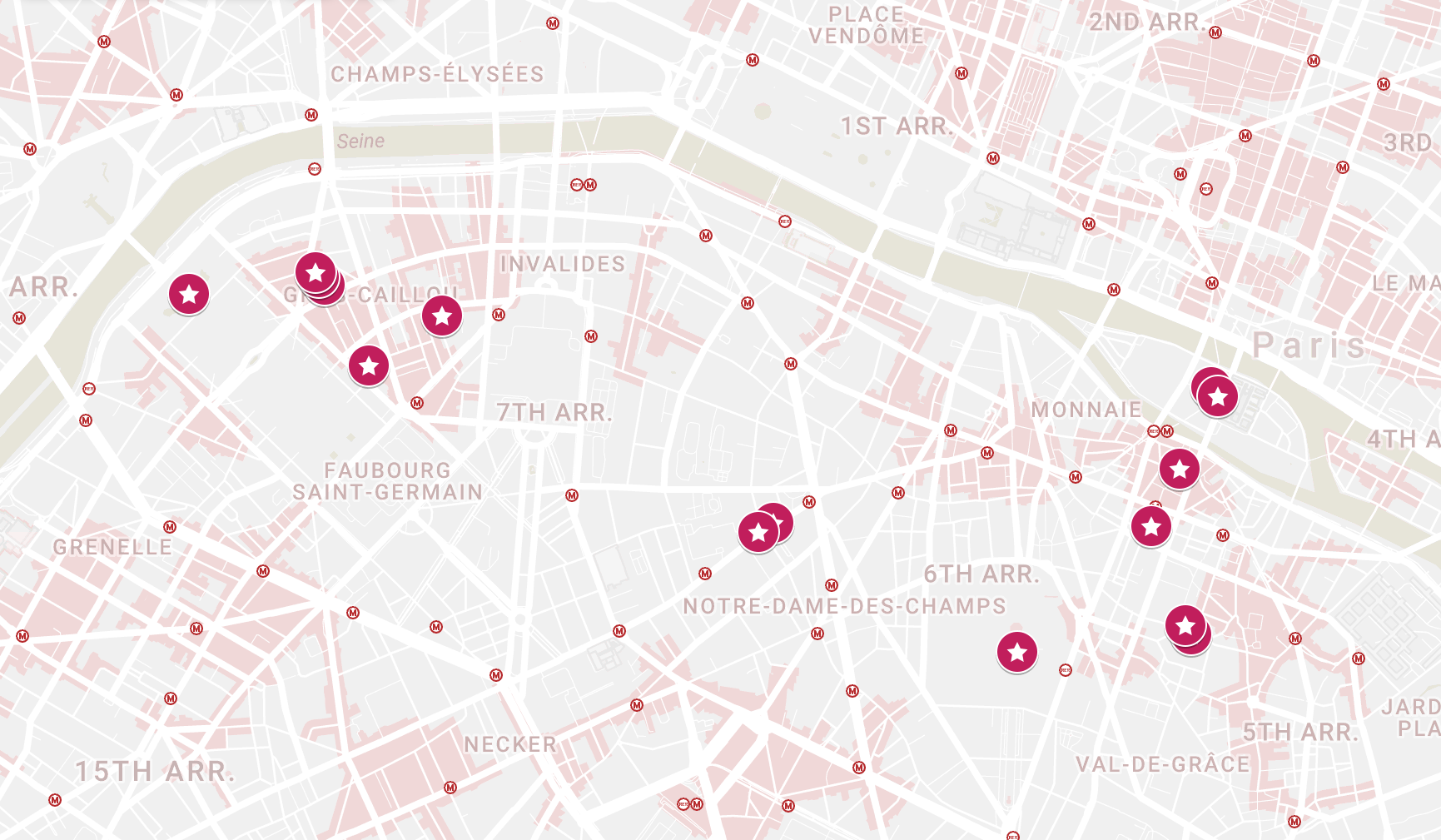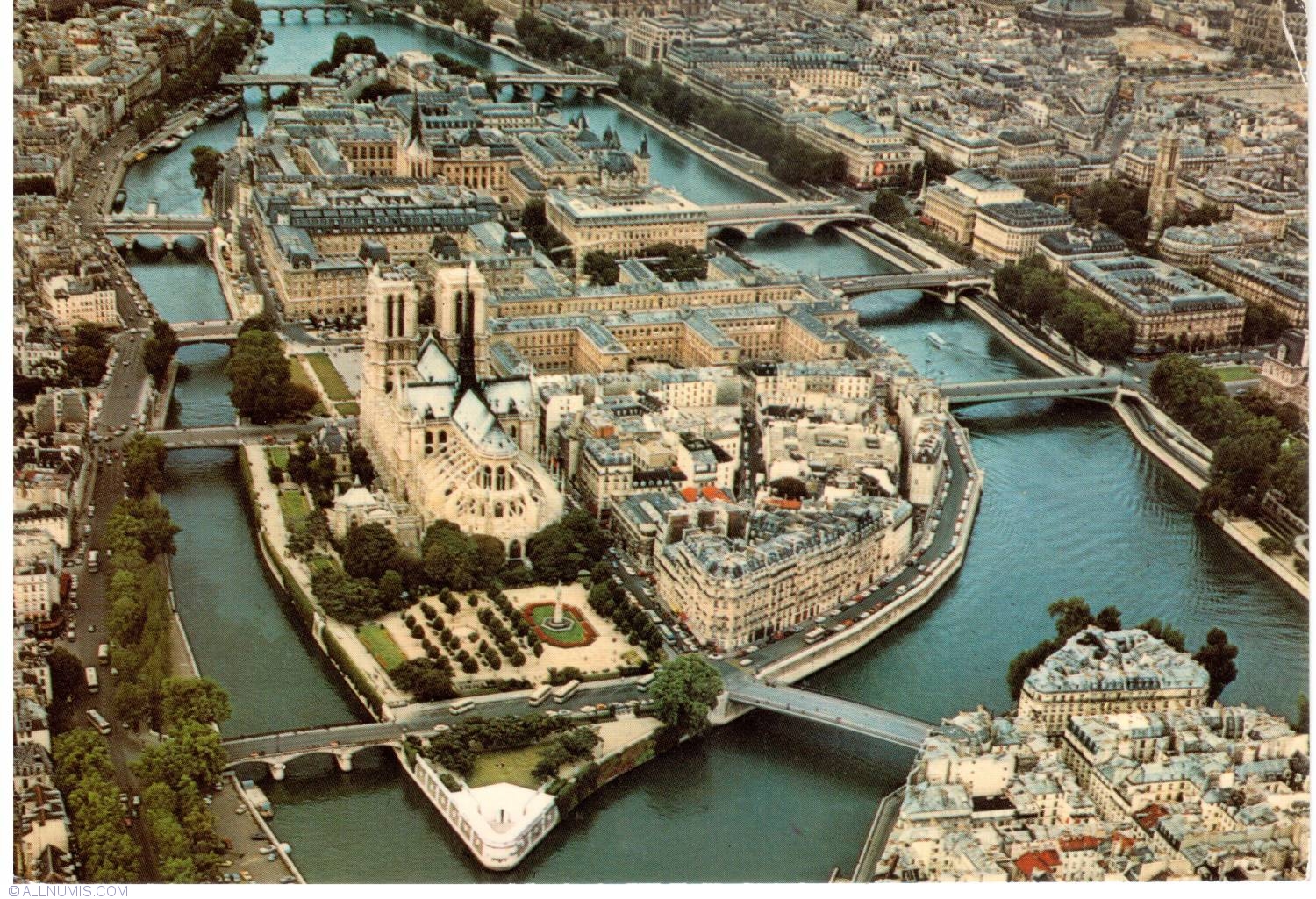Bonjour, flâneurs et flâneuse!
map
Cité
Hector Guimard, 1900
One of the 86 Guimard metro stations that remain standing from his designs for the vast system. Guimard didn't win the competition of 1899 to design the street architecture for the entire system, but was appointed its architect none the less. His entry kiosks (a total of 141 built 1900-12) are built of modular units of iron, ceramic and glass, in two basic types: with or without roofs. (See the former at Abbesses or Porte Dauphine; a replica dating to 2000 is at Châtelet).
Île de la Cité
Central island in the Seine (its neighbor is the Île Saint-Louis), inhabited at least since the Merovingian period (500 AD) and probably actually much earlier by the Parisii tribe in the time of Julius Caesar. It has been strategic ever since, as the easiest place to cross the Seine and to ward off Viking attacks. By the 10th century it became a center of Christian worship when the predecessor to Notre-Dame was founded there.
In spite of its name, the Pont Neuf is actually now the oldest bridge in Paris, completed by Henry IV in 1607. His widow (and Regent of France,1610-42), the great Queen Marie de Medici, hired one of her countrymen, the great Giambologna (second only to Michelangelo as a sculptor), to complete the equestrian sculpture of the king that adorns the bridge. (The current one is an 1818 recreation of the original lost during the French Revolution.) The triangular Place Dauphine is one of the first urbanization projects in Paris. The Cathedral of Notre Dame de Paris dates from 1163 but was significantly altered on the interior by Viollet-le-Duc in the 19th c. The reliquary/palace chapel of Sainte-Chapell was built 1245 by the saintly King Louis IX to house the sacred trinkets he brought back from the Holy Land. It is also has been the scene of gruesome French history; Marie Antoinette was beheaded at the Concierge in 1793.
Saint-Séverin
mostly ca. 13th-15th c.
Named in honor of a hermit who used to live down by the river around 400 AD, when there wasn't much but tribal huts on the Île de la Cité. The site of his grave attracted a cult, which built a small church in the 11th c., which was replaced by this building in the 13th c. It received a significant addition in the next century, and then was rebuilt in a late style after burning in 1448, with the sweeping apse added in 1489. More chapels were added around 1520, with a new sacristy and chapel by 1673, finalizing the church's current appearance. Contemporary stained glass was added in 1970 to complement the surviving medieval glass.
The church is especially well known for its late -Gothic rose window (Flamboyant style) and the unusual, twisty column in the apse that dates to the addition of 1489. (It's worth considering that by that date Brunelleschi had already invented the Renaissance by more than a half-century.)
Musée de Cluny / Musée National du Moyen Âge
Hôtel, 14th-century, rebuilt ca. 1485 (Jacques d'Amboise)
Housed in the Hôtel de Cluny, a spectacular and rare example of French medieval civic architecture. Once part of a large complex for the order of Cluny, converted to use as a museum of medieval and Renaissance decorative arts in 1833. Later work preserved the third-century Roman baths on the site (the frigidarium is part of the museum). Among its notable holdings (furniture, jewels, manuscripts), the tapestries are marvelous, and among them, the Lady and the Unicorn is not to be missed (although it also makes an appearance at Hogwarts).
Le Panthéon (formerly Church of Ste-Geneviève)
Jacques-Germain Soufflot, 1755-80; Jean-Baptiste Rondelet to 1790
Built as a church dedicated to Paris' patron saint, now a burial site of great French citizens. Highly unusual synthesis of a Byzantine Greek-cross plan, Classical pediment, Renaissance dome, Gothic structural principles and Industrial Revolution materials. In 1791 the influence of the Revolution led to the change of function from church to mausoleum. The dome is awash with a fresco of Ste.-Genevieve's apotheosis painted by Antoine Gros in 1818. The crossing was (and remains) the site of Léon Foucault's demonstration of the earth's rotation by means of giant pendulum in the mid-19th c.
Burials include: Louis Braille, Marie Curie, Alexandre Dumas, Victor Hugo, Jean-Jacques Rousseau, Voltaire, Émile Zola, and the architect, Soufflot.
Bibliothèque Sainte-Geneviève
Henri Labrouste, 1838-50
Nearly a perfect mid-century building: by the Prix de Rome winner in the classicizing method favored by the Ecole des Beaux-Arts, shot through with daring iron structure.
Jardin du Luxembourg
Palace, Salomon de Brosse, 1611; original Garden, Tommaso Francini, 1612; Medici Fountain, 1620
Built for Marie de' Medici, widow of the king and regent of the state, upon the king's death in 1611. At its head is the great palace modeled after the 15th-century Pitti palace, where she grew up in Florence, set within a garden designed by an Italian after Renaissance traditions in the queen's home country. Gardens extended by French designer Jacques Boyceau de la Barauderie in 1630 (he also did the Tuileries) in a form that shows the advent of jardin à la française, which reaches its high point at Versailles. Lots of statuary (including the Queens of France and Famous Women series around the central fountain), monuments (a model of the Statue of Liberty, Beethoven, animals, classical figures) and other additions made through the 19th c. The great Medici Fountain takes the form of a grotto, common in Renaissance gardens.
Le Bon Marché (Rive Gauche)
Louis-Auguste Boileau and Alexandre Laplanche, 1869, enlarged 1872 by Lous-Auguste Boileau and Gustave Eiffel
Good market? More like great market! Business founded in 1838 to sell fabrics and habidashery; bigger store built 14 years later. First recognizable department store anywhere, on the model of new, modern retail as imagined by Aristide Boucicault (who invented or popularized the ideas of fixed prices, returns and exchanges, more choice, catalogues, and advertising). Important functionally, also of interest formally and structurally. The Boileu father and son both hired a complement to their own skills: the elder was an engineer who needed design help; the son was a designer who needed an engineer. The whole department store craze of the late 19th c was inspirational to Émile Zola, especially his Au Bonheur des Dames, still a great read.
La Grande Epicerie de Paris
Aristide Boucicaut's department store included a food counter, serving tea and cakes, as of 1923. Later in the 20th c. the idea was expanded to replicate the idea of the department store--vast in choice, high in luxury--to food. Over 32,000 SF offers everything from the simple (water, but offering 100 varieties) to the extraordinary (caviar ravioli), and extraordinary examples of everything in between (cheese, pastry).
Speaking of which, you might like to try: croissant (actually invented by Viennese pastry chefs but certainly perfected in France), éclair (long, thin choux pastry filled with cream and topped with icing), kouign amann (round version of a croissant, sort of, with caramelized sugar), opera cake (many thin layers, soaked in coffee syrup and separated by coffee buttercream and chocolate ganache), macarons (tiny light cookie made with finely ground nuts and sandwiched with cream or chocolate), mille-feuille ("thousand leaves" of thin pastry layered with pastry cream and finished with icing), religieuse (two stacked cream puffs filled with cream, often with lavender icing), Paris-Brest (big choux pastry cut like a hamburger and filled with cream), or a St. Honoré (circle of puffs filled with stiff cream and topped with caramelized sugar and whipped cream).
151 Rue de Grenelle
Jules Aimé Lavirotte, 1898
Next to Guimard, Lavirotte (who studied at the Ecole des Beaux-Arts both in his home town of Lyon and here in Paris) is probably the best-known (and maybe best, but you decide) expositor of the Art Nouveau de Paris. In his work, look for the sinuous, plant-inspired linework you expect in AN, with a strong use of cool new glazed ceramics (in part due to his close association with ceramicist Alexandre Bigot). He won several prizes for Best Facade (and it is interesting, and telling, that Paris had such a prize). This is his first major building, which shows a certain historical view, inspired by the Rococo.
33 Rue du Champ de Mars
Octave Raquin, 1902
Private college building with lots of carved stone inspired by sinuous vegetable growth and featuring a central iron and glass awning over the main entry. The building has the nickname "Maison du arums" for its decorative imagery of lilies. Winner of the Best Facade competition in the year it was complete.
12 Rue Sedillot
Lavirotte, 1899
Commissioned by a countess (the Comtesse de Montessuy) as a private residence. Something of historical, Classical France remains along with the Art Nouveau: see the ceramic columns, exuberant ornament, and studied asymmetry.
3 Square Rapp
Lavirotte, 1899
Apartment building where Lavirotte himself lived. Ornate doorway and whimsical ornament as in his later works. Lots of Bigot tiles. Small fountain also designed by the architect.
29 Avenue Rapp
Lavirotte, 1901
Most famous of Lavirotte's works in Paris, with a heap of Bigot tiles and molded brick. Lavirotte collaborated with artists for many of the finest features of the building, like the doorframe by Jean-Baptiste Larrive. Note asymmetry, organic forms, earth tones, new materials. Look for a zoo's worth of animal decorations, including peacocks, bulls, insects and a very famous salamander.
La Tour Eiffel
Gustave Eiffel, 1887-89
Wrought iron tower, 1063 feet tall, comprising four curving lattice girders joined at three intervals. 1063 feet tall on a square base, 410 feet on a side. When built, it was the tallest structure in the world until the construction of the Chrysler Building in 1930. Although Eiffel gets all the credit, the design was worked out by engineers Maurice Koechlin and Émile Nouguier. A portion of the iron work is non-structural and added for visual concerns (the arches and brackets, for example). The most obvious added ornament is the inscription of 72 names of French scientists, engineers and mathematics around the first level. More subtle, the tower is painted in three shades, darker at the bottom (believing that this makes it look better against the sky).
Not immediately successful, the initial designs were protested by the public and a group of artists known as the Committee of Three Hundred who protested against
this useless and monstrous Eiffel Tower … a giddy, ridiculous tower dominating Paris like a gigantic black smokestack, crushing under its barbaric bulk Notre Dame, the Tour Saint-Jacques, the Louvre, the Dome of les Invalides, the Arc de Triomphe, all of our humiliated monuments will disappear in this ghastly dream. And for twenty years … we shall see stretching like a blot of ink the hateful shadow of the hateful column of bolted sheet metal.
Eiffel responded with an ode to the Egyptian pyramids (which may have had something to do with I.M. Pei's project at the Louvre a century later), suggesting that his tower too might become "grandiose" like them.













